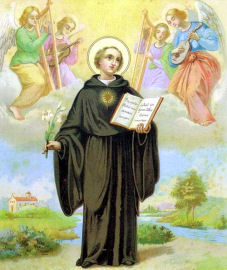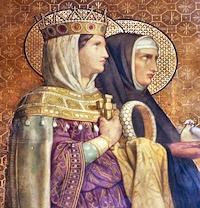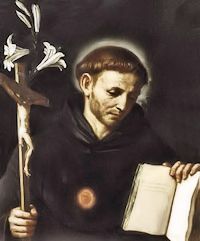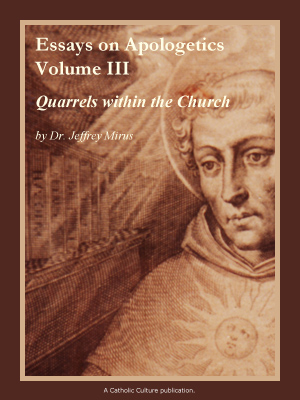Ordinary Time: September 10th
Saturday of the Twenty-Third Week in Ordinary Time
Other Commemorations: St. Nicholas of Tolentino, Confessor (RM); St. Pulcheria (RM)
» Enjoy our Liturgical Seasons series of e-books!
Today the Roman Martyrology commemorates:
—St. Nicholas of Tolentino (1245-1305), a native of Sant' Angelo, in the diocese of Fermo, was born about the year 1245. As a young man, but already endowed with a canon's stall, he was one day greatly affected by a sermon preached by a Hermit of St. Augustine and decided to enter this newly-founded Order. At first he lived at the hermitage of Pesaro and then at Tolentino where he died in 1305. His whole life was remarkable for its great austerity which was inspired by his great love of the cross.
—St. Pulcheria (399-453), daughter of the Byzantine emperor Arcadius (395-408), was co-regent and adviser of her brother Theodosius the Younger (408-450). Throughout her life she defended the Faith against various heresies. After giving away her wealth to the poor and to the Church, she died peacefully at the age of fifty-four in the year 453.
St. Nicholas of Tolentino
This Nicholas was born in answer to his mother's prayers. Childless and in middle age, she had made a pilgrimage with her husband to the shrine of St. Nicholas of Bari to ask for a son whom she promised to dedicate to God's service. When her wish was granted, she named the boy Nicholas and he soon gave unusual signs of saintliness. Already at seven he would hide away in a nearby cave and pray there like the hermits whom he had observed in the mountains.
As soon as he was old enough he was received into the Order of Augustinian friars. On account of his kind and gentle manner his superiors entrusted him with the daily feeding of the poor at the monastery gates, but at times he was so free with the friary's provisions that the procurator begged the superior to check his generosity. He was ordained in 1271 and said his first Mass with exceptional fervor; thereafter, whenever he celebrated the holy Mystery he seemed aglow with the fire of his love. His preaching, instructions and work in the confessional brought about numerous conversions, and his many miracles were responsible for more, yet he was careful not to take any credit for these miracles. "Say nothing of this," he would insist, "give thanks to God, not to me. I am only a vessel of clay, a poor sinner."
 He spent the last thirty years of his life in Tolentino, where the Guelfs and the Ghibellines were in constant strife. Nicholas saw only one remedy to the violence: street preaching, and the success of this apostolic work was astounding. "He spoke of the things of heaven," says his biographer St. Antonine. "Sweetly he preached the divine word, and the words that came from his lips fell like flames of fire. Among his hearers could be seen the tears and heard the sighs of people detesting their sins and repenting of their past lives."
He spent the last thirty years of his life in Tolentino, where the Guelfs and the Ghibellines were in constant strife. Nicholas saw only one remedy to the violence: street preaching, and the success of this apostolic work was astounding. "He spoke of the things of heaven," says his biographer St. Antonine. "Sweetly he preached the divine word, and the words that came from his lips fell like flames of fire. Among his hearers could be seen the tears and heard the sighs of people detesting their sins and repenting of their past lives."
During the last years of his life St. Nicholas was bedridden and suffered grievously. He died surrounded by his community. In 1345 a lay Brother cut off the arms of his body intending to take them to Germany as relics, and the friars then hid his body to prevent further attempts of this kind. It has not been found to this day, but the arms have been preserved. It is recorded that they have bled on several occasions, usually, it is said, before some calamity that befell the Church or the world.
—Excerpted from A Saint A Day by Berchman's Bittle, O.F.M. Cap.
Patronage: Lost souls; mariners; infants; animals; dying people; souls in purgatory
Symbols and Representation: Crucifix and wreath of lilies; flaming star; doves and dish; partridge; fountain; basket with bread rolls; bread; lily; man in black Augustinian habit holding one of the symbols; star above Augustinian; Augustinian with star on breast
Highlights and Things to Do:
- A single phrase from a sermon effected St. Nicholas' conversion and made him a saint. An excellent example of the power of God's word! Christ once said, "Not by bread alone does man live, but by every word that proceeds from the mouth of God." In other terms: Bread nourishes one's physical life, the word of God nourishes one's supernatural life. Recall the parable of the sower about the seed that fell on good ground and produced abundant returns—a parable explained by Jesus Himself. The seed is the word of God. This point is particularly important. The word of God is seed containing limitless vitality. It does not yet live, but requires the good earth to burst into life, to become a living, growing plant. Spend some time today meditating on the words of the Gospel and praying that God will bring similar fruit from your life and make you a saint.
- Read another account of St. Nicholas' life from The Catholic Encyclopedia.
- For further reading, see:
- St. Nicholas had a great love for the Holy Souls. He would offer Mass, pray and do penance for them so they could more quickly enter Heaven. Why not offer up a Mass or pray the Rosary today.
- St. Nicholas blessed bread and distributed it to the poor and sick after he prayed for Mary's healing intercession. A tradition remains with St. Nicholas' Bread, a roll of dough with a cross in the center. See Blessing of Bread and Icon and JSTOR.
- See about St. Nicholas' statue in the St. Peter's Basilica Colonnade.
- The Convento di San Nicola located in the center of the beautiful town of Tolentino is a very popular place of pilgrimage. It has one of the most important fresco cycles of the 1300s, painted by the Master of Tolentino. There are also many excellent paintings in the elegant baroque basilica, a memorable cloister, the cell where St. Nicholas of Tolentino lived, and an interesting museum containing some fine ceramics. St. Nicholas is buried in the crypt.
St. Pulcheria
 Empress of the Eastern Roman Empire, eldest daughter of the Emperor Arcadius, born 19 January 399; died in 453. After the death of Arcadius (408), her younger brother, Theodosius II, then only seven, became emperor under the guardianship of Anthimus. Pulcheria had matured early and had great administrative ability; she soon exerted salutary influence over the young and not very capable emperor. On 4 July 414, she was proclaimed Augusta (empress) by the Senate, and made regent for her brother. She made a vow of virginity and persuaded her sisters to do the same, the imperial palace thus becoming almost a monastery. At the same time she fulfilled all her duties as a ruler for about ten years jointly with her brother. After the marriage, brought about by Pulcheria, of Theodosius II with Eudoxia, the new empress sought to weaken Pulcheria’s influence over the emperor, and, with the aid of some courtiers, succeeded for a time. Nevertheless, Pulcheria had always a powerful position at Court, which she used in behalf of ecclesiastical orthodoxy, as shown by her opposition to the doctrines of Nestorius and Eutyches. Eudoxia supported Nestorius. Saint Cyril of Alexandria sent Pulcheria his work, “De fide ad Pulcheriam”, and wrote her on behalf of the true Church doctrine, to which she held unwaveringly (letter of Cyril in Mansi). He also wrote to Eudoxia. Theodosius allowed himself to be influenced by Nestorius to the prejudice of Cyril, whom he blamed for appealing to the two empresses. Pulcheria, however, was not deterred from her determination to work against Nestorius and to persuade the emperor to espouse Cyril’s party which favoured the definition of the Council of Ephesus. In the further course of the negotiations over the Council of Ephesus, the Patriarch of Alexandria sought to gain Pulcheria’s zeal and influence for the union and sent her presents as he did to other influential persons at the Court. There is no doubt that the final acknowledgement by the emperor of the condemnation of Nestorius was largely due to Pulcheria. The Nestorians, consequently, spread gross calumnies about her (Suidas, s.v. Pulcheria). Court intrigues obliged her (446) to leave the imperial palace and retire to a suburb of Constantinople, where she led a monastic life. When the Empress Eudoxia went to Jerusalem, Pulcheria returned (about 449) to Court. At the emperor’s death (28 July 450) she was proclaimed empress, and then married the able general, Marcian, but with the condition that her vow of virginity should be respected. At her order Marcian was proclaimed Augustus.
Empress of the Eastern Roman Empire, eldest daughter of the Emperor Arcadius, born 19 January 399; died in 453. After the death of Arcadius (408), her younger brother, Theodosius II, then only seven, became emperor under the guardianship of Anthimus. Pulcheria had matured early and had great administrative ability; she soon exerted salutary influence over the young and not very capable emperor. On 4 July 414, she was proclaimed Augusta (empress) by the Senate, and made regent for her brother. She made a vow of virginity and persuaded her sisters to do the same, the imperial palace thus becoming almost a monastery. At the same time she fulfilled all her duties as a ruler for about ten years jointly with her brother. After the marriage, brought about by Pulcheria, of Theodosius II with Eudoxia, the new empress sought to weaken Pulcheria’s influence over the emperor, and, with the aid of some courtiers, succeeded for a time. Nevertheless, Pulcheria had always a powerful position at Court, which she used in behalf of ecclesiastical orthodoxy, as shown by her opposition to the doctrines of Nestorius and Eutyches. Eudoxia supported Nestorius. Saint Cyril of Alexandria sent Pulcheria his work, “De fide ad Pulcheriam”, and wrote her on behalf of the true Church doctrine, to which she held unwaveringly (letter of Cyril in Mansi). He also wrote to Eudoxia. Theodosius allowed himself to be influenced by Nestorius to the prejudice of Cyril, whom he blamed for appealing to the two empresses. Pulcheria, however, was not deterred from her determination to work against Nestorius and to persuade the emperor to espouse Cyril’s party which favoured the definition of the Council of Ephesus. In the further course of the negotiations over the Council of Ephesus, the Patriarch of Alexandria sought to gain Pulcheria’s zeal and influence for the union and sent her presents as he did to other influential persons at the Court. There is no doubt that the final acknowledgement by the emperor of the condemnation of Nestorius was largely due to Pulcheria. The Nestorians, consequently, spread gross calumnies about her (Suidas, s.v. Pulcheria). Court intrigues obliged her (446) to leave the imperial palace and retire to a suburb of Constantinople, where she led a monastic life. When the Empress Eudoxia went to Jerusalem, Pulcheria returned (about 449) to Court. At the emperor’s death (28 July 450) she was proclaimed empress, and then married the able general, Marcian, but with the condition that her vow of virginity should be respected. At her order Marcian was proclaimed Augustus.
Meantime, at Constantinople, Eutyches had announced his heresy of the unity of the natures in Christ, and the Patriarch Flavian had expressed his opposition, as did also Pope Leo I. Once more Pulcheria took up the cause of the Church. On 13 June 449, the pope had written both to Pulcheria and to Theodosius, requesting them to end the new heresy. Nine other letters followed. Theodosius II confirmed the decisions of the Robber Synod of Ephesus (449) and the pope, who had rejected them, sought to bring the emperor back to orthodox opinions. On 13 October 449, he wrote again to the emperor and also to Pulcheria, begging the latter for aid. The Roman Archdeacon Hilarius also wrote with the same object, and at Leo’s entreaty Valentinian III of the Western Empire, with Eudoxia and Galla Placidia, wrote to Theodosius and Pulcheria. Another letter to Pulcheria was sent by Leo on 16 July, 450 (Epist. lxx). After the death of Theodosius, conditions were at once changed. Marcian and Pulcheria wrote to Leo (Epist. lxxvii). She informed him that the Patriarch Anatolius had expressed his approbation and had signed the papal letter to Flavian concerning the two natures in Christ. She requested the pope to let it be known whether he would attend personally the council that had been summoned. The empress was influential in the Council of Chalcedon (451) and with the emperor attended the sixth session (25 Oct., 451). Leo in his letter of 13 April, 451 (Epist. lxxix), wrote Pulcheria that both the Nestorian and Eutychian heresies had been overcome largely by her efforts. He thanked her for the benefits she had bestowed on the Church, for her support of the papal legates, for the recall of the banished Catholic bishops, and for the honourable burial of the body of the Patriarch Flavius. Pulcheria showed no less zeal in promoting other interests of the Church. She built three churches in Constantinople in honour of Mary the Mother of God; one, erected after the condemnation of the Nestorian heresy, was exceedingly beautiful. In other places also she built churches, hospitals, houses for pilgrims, and gave rich gifts to various churches. She had the bones of Saint John Chrysostom, who had died in exile, brought back to Constantinople and buried in the church of the Apostles on 27 January 438; this led to the reconciliation with the Church of the schismatic party of the Johannines. Pulcheria had the relics of the forty martyrs of Sebaste, which were found near Constantinople, transferred to a church. She is venerated as a saint in the Greek and other Oriental Churches as well as in the Latin Church. Her feast is given under 10 Sept. in the Roman Martyrology and in the Greek Menaia; in the other Oriental calendars it is under 7 Aug.
—Excerpted from The Catholic Encyclopedia
Highlights and Things to Do:
- Read this account of St. Pulcheria's life in Butler's Lives of the Saints.
- For the historian here's The Life and Times of the Empress St. Pulcheria.
- Read the article The Woman Who Saved Orthodoxy—Twice.






